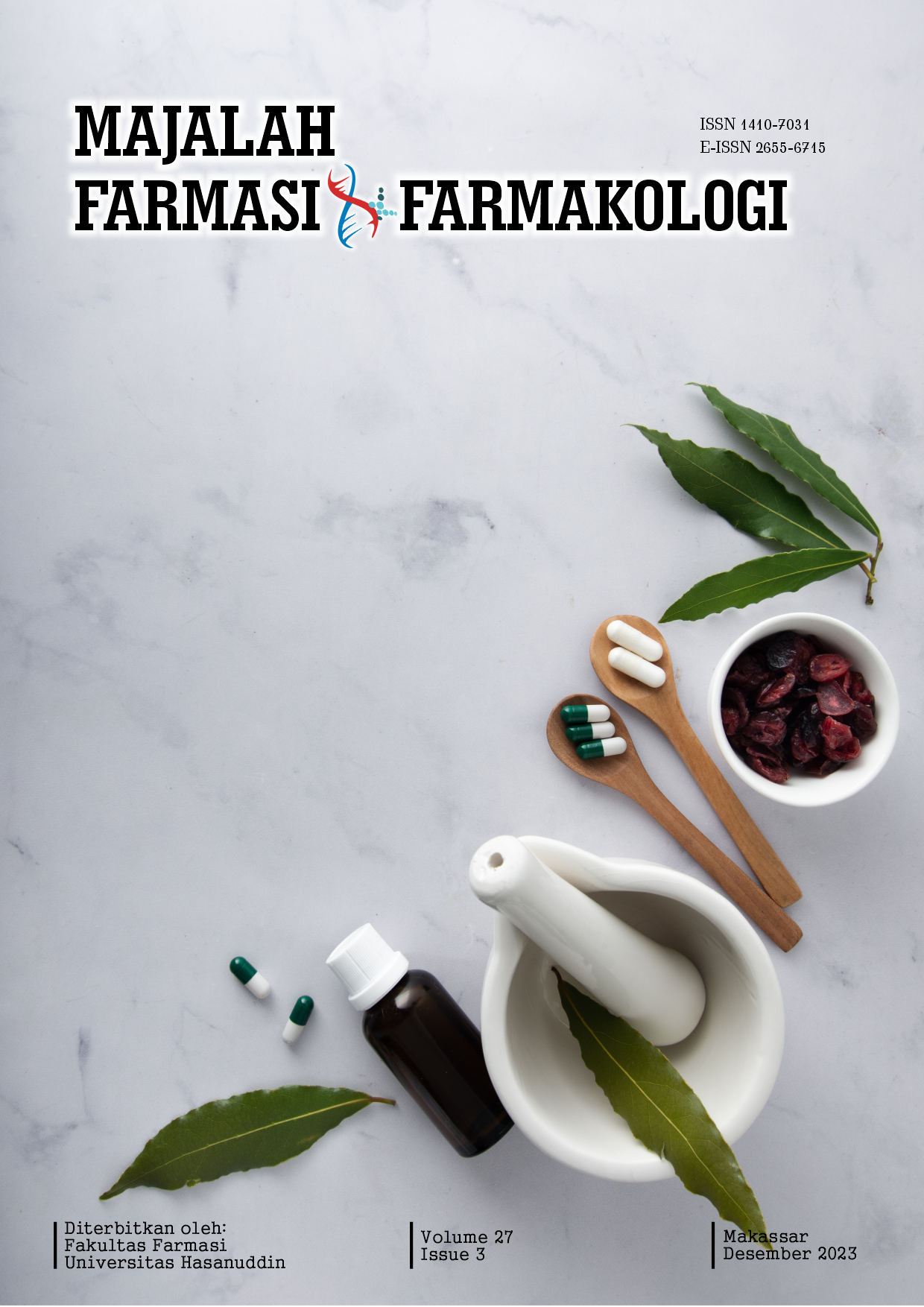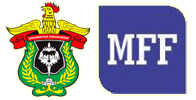PENGOLAHAN SELULOSA MIKROKRISTAL GRADE FARMASI DARI BEBERAPA BAGIAN TANAMAN TERATAI PUTIH (Nymphaea nouchali Burm. F.): PREPARASI & UJI KUALITATIF SERBUK
Keywords:
alfa selulosa, isolasi selulosa, selulosa mikrokristal, Nymphaea nouchali, teratai putihAbstract
Obat memiliki kebermanfaatan yang penting dalam pelayanan kesehatan yang dapat digunakan dalam meningkatkan derajat kesehatan masyarakat. Namun, industri farmasi di Indonesia masih sangat tergantung dengan bahan baku impor. Proses ekstraksi biasanya menghasilkan residu (ampas ekstraksi) berupa serbuk simplisia yang tidak digunakan lagi (limbah padat organik). Pemanfaatan residu hasil ekstraksi pada tanaman teratai putih masih sangat minim, sehingga residu dari hasil ekstraksi tanaman ini dapat diolah menjadi bahan baku pembuatan selulosa mikrokristal. Penelitian ini bertujuan untuk mendapatkan selulosa mikrokristal dari beberapa bagian pada tanaman teratai putih, kemudian dilakukan pengujian kualitas serbuk dengan Avicel PH 101 sebagai bahan baku pembanding. Berdasarkan hasil penelitian, bagian dari tanaman teratai putih yang memiliki kandungan α-selulosa dengan rendemen tertinggi adalah pada bagian tangkai bunga dengan rendemen sebesar 29,02% terhadap serbuk simplisia, diikuti dengan bagian tangkai daun sebesar 22,41%, bagian bunga sebesar 18,72%, dan paling rendah bagian daun yaitu sebesar 7,70%. Selulosa mikrokristal dengan rendemen tertinggi diperoleh oleh bagian daun dengan persentase rendemen sebesar 97%, diikuti dengan bagian tangkai daun sebesar 89%, bagian bunga sebesar 88%, dan rendemen terendah oleh bagian tangkai bunga dengan persentase sebesar 83%. Sifat fisik dari serbuk selulosa mikrokristal teratai putih baik pada daun, tangkai daun, bunga, maupun tangkai bunga, menunjukkan kemiripan karakteristik dengan Avicel® PH 101 sebagai baku pembanding, meliputi reaksi warna, organoleptis, kelarutan, dan pH. Berdasarkan penelitian yang telah dilakukan, kualitas serbuk selulosa mikrokristal dari beberapa bagian tanaman teratai putih (bunga, tangkai bunga, daun, dan tangkai daun) memiliki kemiripan dengan baku pembandingnya, yaitu Avicel® PH 101.References
Lestari, Y.P.I., Falya, Y., Chasanah, U., Kusumo, D.W., & Bethasari, M. Isolasi α-Selulosa, Pembuatan & Karakterisasimikrokristalin Selulosa (MCC) dari Limbah Kulit Jeruk Baby (Citrus sinensis). Majalah Farmasi dan Farmakologi. 2022; 26(3):119-123.
Kementrian Perindustrian. Buku Analisis Pembangunan Industri - Edisi II 2021. Jakarta: Kemenperin; 2021.
Angga, L. P. Pengaruh Kompetensi Dan Kinerja Karyawan Terhadap Pengembangan Karir Melalui Motivasi Sebagai Variabel Intervening Di Kantor Bpjs Ketenagakerjaan Cabang Madiun (Doctoral dissertation, Universitas Muhammadiyah Ponorogo); 2018.
Kemenkes RI. Rencana Strategis Kementerian Kesehatan Tahun 2020-2024. Published online. 2020;1–69.
Spillane, J. J. Ekonomi Farmasi. Yogyakarta: Grasindo; 2010.
BPS Kalimantan Selatan. Biro Pusat Statistik Kalimantan Selatan, Banjarmasin. 2000.
Khairunnisa, A., Wathan, N., Fitriana, M., Fadlilaturrahmah, & Fiddina, N. Aktivitas Antibakteri Ekstrak Metanol Bunga Teratai (Nymphaea pubescens Willd). Jurnal Pharmascience. 2020; 7(2): 75-88.
RuangBerkas.com. Kandungan Tanaman Teratai. Tersedia di: http://www.khasiatbuahcom/teratai.html. 2012. [19 Mei 2023].
Dhuha, N.S. & Wahid, A. Aktivitas Senyawa Bioaktif Ekstrak Bunga Teratai Putih (Nymphaea alba L) terhadap Pseudomonas aeruginosa dan Staphylococcus aureus dengan Metode Bioautografi. Medical Sains. 2020; 5(1): 69-78.
Sasongko, H., Farida, Y., & Susanto. Optimalisasi Pengolahan Limbah Ekstraksi Usaha Kecil Obat Tradisional Sebagai Pakan Ternak. Jurnal SEMAR. 2016; 5(1): 51-57.
Usman, R., Putra, M.F., & Sari, R.I.P. Pengolahan Limbah Ampas Ekstrasi Jamu Menjadi Pupuk Kompos. Prosiding Seminar Nasional Pengabdian Masyarakat LPPM UMJ. 2019: 1-7.
Kalia, S., Kaith, B.S., & Kaur, I. Cellulose-Based Bio- and Nanocomposites: A Review. International Journal of Polymer Science. 2011. Article ID: 837875.
Brinchi, L., Cotana, F., Fortunati. E., Kenny, J.M. Production of nanocrystalline cellulose from lignocellulosic biomass: technology and applications. Carbohydrate Polymer. 2013; 94(1): 154-69. doi: 10.1016/j.carbpol.2013.01.033.
Hindi, Z.S.S. Microcrystalline Cellulose: The Inexhaustible Treasure for Pharmaceutical Industry. Nanoscience and Nanotechnology Research. 2017; 4(1): 17–24. https://doi.org/10.12691/nnr-4-1-3.
Lestari, Y.P.I. Optimasi Konsentrasi HCl Pada Proses Hidrolisis Untuk Pembuatan Mikrokristalin Selulosa (MCC) dari Eceng Gondok. Journal Of Innovation Research And Knowledge. 2022; 1(10): 1335-1344.
Hasanah, M., Rizkyah, M.A.P., & Kiki Amelia. Potensi Antioksidan Ekstrak dan Fraksi Daun Eceng Gondok (Eichhornia crassipes (Mart.) Solms) yang Berasal dari Salah Satu Rawa di Palembang, Indonesia. Jurnal Penelitian Sains. 2016; 18(3): 21-119.
Tao Y., Junwen, L., Qinlu, L., and Xiaoqing, J. Penicillium expansum YT01: A Lignocellulose- degrading fungal strain isolatd from China Gaoligong Mountain humus soil. Journal of Biobased Materials and Bioenergy. 2009; 3(4): 348-353.
Lestari, Y. P. I., Suryadi, H., Mi’rajunnisa, Mangunwardoyo, W., Sutriyo, & Yanuar, A. Characterization Of Kapok Pericarpium Microcrystalline Cellulose Produced Of Enzymatic Hydrolysis Using Purified Cellulase From Termite (Macrotermes gilvus). International Journal Of Pharmacy And Pharmaceutical Sciences. 2020; 2(3): 7-14.
Santos A. A. D. & Wahyuningtyas, D. Karakterisasi Mikrokristalin Selulosa Dari Daun Jambu Biji (Psidium guajava L) Sebagai Eksipien Tablet Obat Diare (Variasi Penambahan Serbuk Daun Jambu Biji). 2019; 4(1): 1-7.
Pine, A. T. D., Base, N.H., & Angelina, J.B. Produksi dan Karakterisasi Serbuk Selulosa dari Batang Pisang (Musa paradisiaca L.). Jurnal Kesehatan Yamasi Makassar. 2021; 5(2): 115-120.
Syam, L.K., Farikha J., Fitriana, & Dian N. Pemanfaatan Limbah Pod Kakao Untuk Menghasilkan Etanol Sebagai Sumber Energi Terbarukan. 2009. Tersedia di : http://repository.ipb.ac.id/handle/1234567 89/20208 [Diakses pada tanggal 22 Mei 2023].
Badaring, D.R., Sari, S.P.M., Nurhabiba, S., Wulan, W., & Lembang, S.A.R. Uji Ekstrak Daun Maja (Aegle marmelos L.) terhadap Pertumbuhan Bakteri Escherichia coli dan Staphylococcus aureus. Indonesian Journal of Fundamental Sciences. 2020; 6(1): 16-26.
Umar, S.T. Pemanfaatan serat Rami untuk Pembuatan Selulosa. Datin litbang BPP Kemenham RI. 2011. Tersedia di: http://www.balibang.kemhan.go.id/?q=co ntent/pemanfaatan-serat-rami-untuk-pembuatan-selulosa [Diakses tanggal 22 Mei 2023].
Edison, Diharmi A, & Sari ED. Karakteristik selulosa mikrokristalin dari rumput laut merah Eucheuma cottonii. Jurnal Pengolahan Hasil Perikanan Indonesia. 2019; 22(3): 483-489.
Nurhayani, F. Karakterisasi Selulosa Mikrokristal dari Daun Nanas sebagai Eksipien Tablet Metode Kempa Langsung [Skripsi]. Jatinangor: Universitas Padjadjaran; 2008.
Martawijaya A. & Barly. Keawetan dan Keterawetan Beberapa Jenis Kayu yang Berasal dari Hutan Alam dan Hutan Tanaman. Prosiding Diskusi HTI. Jakarta: Badan Penelitian dan Pengembagan Kehutanan; 2009.
Tashiro, K. & Gakhutishvili, M. Crystal Structure of Cellulose-Iodine Complex. Polymer. 2019; 171: 140-148.
Agustin, N., Chaerunisaa, A.Y., & Abdassah, M. Review Artikel: Isolasi dan Karakterisasi Selulosa Mikrokristal dari Buah Nanas (Ananas comosus L. Merr). Jurnal Farmaka. 2021; 19(2): 128-135.
Cowd, M.A. Kimia Polimer. Bandung: Institut Teknologi Bandung; 1991.
Allen, L. V. Handbook of Pharmaceutical Excipients, Sixth Edition, Rowe, R. C., Sheskey, P. J., Queen, M. E., (Editor), London, Pharmaceutical Press and American Pharmacists Assosiation; 2009.
Komala, W.O.R.N., Mita, N., & Sastyarina, Y. Karakteristik Rumput Banto (Leersia hexandra Sw.) Berdasarkan Makroskopik dan Mikroskopik. Proceeding of Mulawarman Pharmaceuticals Conferences. 2020: 33-37.
Downloads
Published
Issue
Section
License
Copyright (c) 2023 Majalah Farmasi dan Farmakologi

This work is licensed under a Creative Commons Attribution-NonCommercial 4.0 International License.
The copyright to this article is transferred to Universitas Hasanuddin (UNHAS) if and when the article is accepted for publication. The undersigned hereby transfers all rights in and to the paper including without limitation all copyrights to UNHAS. The undersigned hereby represents and warrants that the paper is original and that he/she is the author of the paper, except for material that is clearly identified as to its original source, with permission notices from the copyright owners where required. The undersigned represents that he/she has the power and authority to make and execute this assignment.
We declare that:
- This paper has not been published in the same form elsewhere.
- It will not be submitted anywhere else for publication prior to acceptance/rejection by this Journal.
- A copyright permission is obtained for materials published elsewhere and which require this permission for reproduction.
Furthermore, I/We hereby transfer the unlimited rights of publication of the above-mentioned paper in whole to UNHAS The copyright transfer covers the exclusive right to reproduce and distribute the article, including reprints, translations, photographic reproductions, microform, electronic form (offline, online) or any other reproductions of similar nature.
The corresponding author signs for and accepts responsibility for releasing this material on behalf of any and all co-authors. This agreement is to be signed by at least one of the authors who have obtained the assent of the co-author(s) where applicable. After submission of this agreement signed by the corresponding author, changes of authorship or in the order of the authors listed will not be accepted.


